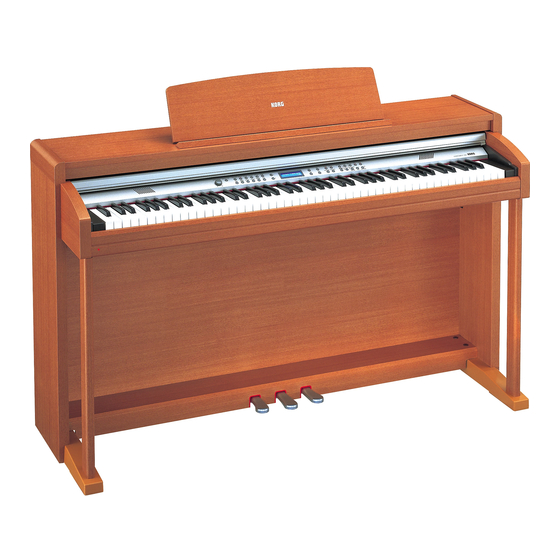
Korg C-520 Handbücher
Anleitungen und Benutzerhandbücher für Korg C-520. Wir haben 1 Korg C-520 Anleitung zum kostenlosen PDF-Download zur Verfügung: Bedienungsanleitung
Korg C-520 Bedienungsanleitung (298 Seiten)
DIGITAL PIANO
Marke: Korg
|
Kategorie: Musikinstrumente
|
Dateigröße: 8.58 MB
Inhaltsverzeichnis
-
English
7-
Connections13
-
-
-
-
Brilliance53
-
Fast Play55
-
Mute Level55
-
MIDI Clock56
-
MIDI Filters58
-
MIDI61
-
Polyphony70
-
Français
75-
Introduction76
-
Connexions81
-
Le Métronome93
-
-
-
Régler le Volume115
-
-
Brilliance123
-
Fast Play125
-
Couper le Volume125
-
MIDI Clock126
-
Canaux MIDI in127
-
Canaux MIDI out127
-
Filtres MIDI128
-
MIDI131
-
Polyphonie140
-
-
Deutsch
145-
Einleitung146
-
Bedienfeld148
-
Anschlüsse151
-
Das Metronom162
-
-
-
-
Brilliance191
-
Fast Play193
-
MIDI Clock194
-
MIDI IN-Kanäle195
-
MIDI OUT-Kanäle195
-
MIDI-Filter196
-
MIDI199
-
Fehlermeldungen207
-
Fehlersuche208
-
Polyphonie208
-
Technische Daten209
-
-
Italiano
213-
Introduzione214
-
Collegamenti219
-
Il Metronomo231
-
-
-
Salvare un Suono249
-
-
Brillantezza259
-
Livello del Mute261
-
MIDI Clock262
-
Canali MIDI in263
-
Canali MIDI out263
-
Filtri MIDI264
-
Reset Generale266
-
MIDI267
-
Polifonia276
-
-
Anhang279
-
Werbung
Werbung
